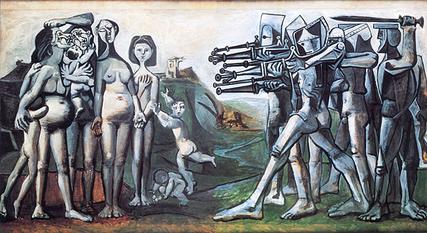So Picasso himself, I've had mixed emotion about. On one had he is Twentieth Century Art with a capital "A". On the other hand, the process of the art is such that it becomes unmoored from representational art and starts drifting, balloon like, into an emotional realm.
What that means is, that when it works, it works very, very well, and when it doesn't, you end up scratching the side of you head and asking "Is that a nose? Is that an idealization of a nose?" When I was young LIFE or LOOK magazine did an article on Picasso (this was in the 60s) and then two weeks later ran a series of letters, each one of which declared that their seven/six/five/four/three/two year old could paint better. Which is part of the point and nothing like the point.
This Picasso, he confuses me, and I think he wanted it that way.
The exhibition itself comes from the Musee National Piccaso in Paris and reflects works that the artist considered part of this legacy, and consists of finished works as well as sketches, studies, and uncompleted projects. That gives an idea of what lies behind the thinking, as well as minor or personal work. Les Demoiselles d'Avignon is not here, but represented by similar works, and Guernica shows up as preliminaries and a photo-progression of the work shot by one of his lovers. Yet he has generated so much material, in so many different media and in so many different ways, that the entire experience is unexpectedly overwhelming. I overheard one patron say that he felt like he had just left a Thanksgiving dinner - he was overloaded on art.
And of the art, yes, the early Blue and Rose periods show him capable and establishing himself as an Artist-with-an-A. It is his cubist work that connects for me at the most basic level - I find the transformation of figure into planes and the creation of motion through angles to be exciting. This is the part that works. And yet after this, as it moves most fully into Picasso' style of teardrop shapes and morphable eyesockets that I lose a bit, that the excitement is not as present. It feels like he is doing art because that is what he does.
 |
| Massacre in Korea, Pablo Picasso, 1951 |
I guess that is where I come down to on one of the finest artists of the 20th Century. When inspired, when in action (ever with still lives and portraits), the artist Pablo Picasso was impossible to define except in terms of his own brilliance. He had the ability to reach into the heart of his subject without directly stating it - he was jazz in a visual media. And when it doesn't work, whether for limitations on the part of the artist or the viewer, it feels like a parody of his material, like the 60s comic artists (and yeah, you can see Bob Crumb in some of the work, or Basil Wolverton),
Sometimes he was pushing the envelope to see what lies next, and sometimes Pablo Picasso was following in the well-trod path of ... well, Pablo Picasso.
The exhibit is in town for only a week more, and worth cutting class to see it. Good luck with the crowds.
More later,


